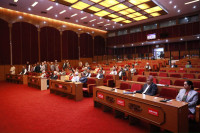Columns
Geographical indications for export promotion
Nepal may not compete in international trade on scale, but it does have unique products to sell..jpg&w=900&height=601)
Madhu K Marasini
Darjeeling tea holds additional value in the market compared to generic black tea. Chocolates, watches, and knives from Switzerland are in high demand and command high premia globally for the quality associated with the Swiss name. Whisky from Scotland is popular worldwide, as is Champagne from France. An additional value is paid to those products because of their origin in a particular geographical region carrying special qualities and a reputation. In international trade, they are recognised and protected as a form of intellectual property, called geographical indications (GI). According to the World Intellectual Property Organisation, geographical indications are products that have a specific spatial origin and possess qualities or a reputation that are due to that origin.
Once we understand what the definition is, it is easy to envision typical Nepali products that could potentially be sold as GI. Perhaps it could be Nepali mountain coffee or Dolakha Yak cheese? Or what about the Gorkha Khukuri? Taplejung large Cardamom? The list goes on. There is a prospect of applying GI in Nepal-made products and promoting export trade. This could contribute to minimising the soaring trade deficit as well. For a product to be considered GI, it has to follow certain rules and standards apart from proving its origin in a particular geographical region. The same rule, standard, and quality assurance then provide the recognition and protection to such a product.
Historically, it was the Paris Convention of Industrial Property in 1883 that laid the foundation towards applying multilateral protection of indications of source and tag of origin. More recently, the World Trade Organisation Agreement on Trade-Related aspects of Intellectual Property Rights (TRIPS) in 1994 provided the international legal foundation for geographical indications. Section 3, Article 22 of TRIPS clearly provides protection for geographical indications which identify a good as originating in the territory of a member, or a region or locality in that territory, where a given quality, reputation or other characteristics of the good is essentially attributable to its geographical origin. The aim is to prevent the public from being misled. There are stronger protections in Article 23 for wines and spirits which needs to be extended to all geographical indications.
Nepal should be able to market its unique products by leveraging the distinct topography, climate, and culture. Many items made in Nepal, such as different types of medicinal and herbal products found in the mountains and hills, Nepali ginger and large cardamom, tea, coffee, carpets, pashmina, Bhaktapur Ju Ju Dhau (curd), etc. can be registered as GI and exported to the international market at higher prices than what they go for today. But this needs to be preceded by extensive marketing and quality control. It took more than 150 years for Champagne to be a universally coveted and recognised brand of sparkling wine, for example. Many constraints will limit our capacity to produce many products on a large scale and be competitive in the global market. However, we have comparative advantage rooted in our unique geography and can produce distinct high-value, low-volume products which are easier to ship. Branding many Nepali exports as GI could boost exports as has been the case with the success of Nepali Orthodox tea in Japan.
Recently, in an article in the New York Times titled, ‘Don’t Call it Darjeeling, It’s Nepali Tea,’ Max Falkwitz eloquently presented the growing prospects and popularity of Nepali tea. He highlighted that in Nepal, growers have been planting tea bushes in the steep high elevation fields that granted Darjeeling its unmatched reputation. The Nepali growers are planting and producing tea in a remarkable style at a fraction of the price with younger, more vigorous bushes thriving in comparatively richer soil. Slowly, Nepal tea is also gaining popularity in the international market. Until recently, all Nepali teas were being exported into the global market as Darjeeling tea, with local growers missing out on the higher value that traders of Darjeeling tea received. According to the Nepal Tea and Coffee Board, Nepal’s 46 districts have a suitable climate to grow tea. As one of the most popular consumable items globally, obtaining a geographical indication tag for Nepal tea would carry major prospects.
A trade and development project, supported by the European Union, identified the value chain development of four Nepali products, namely, tea, coffee, Chyangra pashmina, and Lokta paper as GI. A report produced by the project recommends that five basic pillars have to be met for a functioning GI, namely, legal framework, proven geographic connection, producer organisations to lodge the GI application, a code of practice, and a guarantee system.
With regard to legal preparation, a geographical indication-specific legal framework has to be expedited. It was in the absence of an Intellectual Property Rights Act that an American company registered its property right over Basmati rice, and an Indian company had to challenge that in court stating that Basmati rice is grown only in the northwest of the Indian subcontinent. This is an example of the urgent need for an Intellectual Property Rights framework to protect our intellectual property and the unique products that belong to Nepal.
Equally important is to have the code of practice specifying the technical specifications and geographical boundaries, and also establishing links with geographical latitude and longitude, traceability, and related descriptions. In the case of tea and coffee value chains, the Nepal Tea and Coffee Development Board could be a suitable institution to become a GI lodger.
An alternative way to international trade is necessary when the traditional way of doing business fails to yield the expected revenue for Nepal. If we can associate typical Nepali products with our geographical uniqueness, they can be sold at a higher price in the global market. Obtaining the geographical indication tag would also ensure consistency in quality. All this is easier said than done, of course, but a consolidated effort on the part of all stakeholders is long overdue.
***
What do you think?
Dear reader, we’d like to hear from you. We regularly publish letters to the editor on contemporary issues or direct responses to something the Post has recently published. Please send your letters to [email protected] with "Letter to the Editor" in the subject line. Please include your name, location, and a contact address so one of our editors can reach out to you.




 19.12°C Kathmandu
19.12°C Kathmandu















